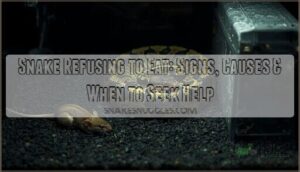This site is supported by our readers. We may earn a commission, at no cost to you, if you purchase through links.
 Setting up snake housing for beginners starts with choosing the right enclosure size – at least 40 gallons for most species.
Setting up snake housing for beginners starts with choosing the right enclosure size – at least 40 gallons for most species.
You’ll need proper heating with a basking spot around 88-92°F and a cool side at 78-80°F.
Use appropriate substrate like aspen shavings or cypress mulch, avoiding cedar or pine.
Add hiding spots on both warm and cool sides, plus a water bowl large enough for soaking.
Maintain 50-60% humidity for most species.
Don’t forget secure screening and proper ventilation.
Temperature gradients are essential – snakes need options to thermoregulate.
Getting these fundamentals right prevents most common health issues and creates a thriving environment where your snake can exhibit natural behaviors.
Table Of Contents
- Key Takeaways
- Choosing The Right Snake
- Setting Up Your Snake’s Home
- Essential Snake Supplies
- Creating a Safe and Healthy Environment
- Feeding Your Snake
- Snake Health and Safety
- Handling and Interacting With Your Snake
- Maintaining a Clean and Hygienic Terrarium
- Advanced Snake Care and Considerations
- Frequently Asked Questions (FAQs)
- How do I bring a snake home?
- How do I choose a snake housing?
- How do you choose a snake enclosure?
- How do I choose a snake habitat?
- What is snake housing?
- Where can I buy a snake enclosure?
- What does a snake need in their enclosure?
- What to put in the bottom of a snake tank?
- What is the best housing for snakes?
- What to do when you first bring a snake home?
- Conclusion
Key Takeaways
- You’ll need to choose the right enclosure size, at least 40 gallons for most species, and set up proper heating with a basking spot and a cool side to create a comfortable environment for your snake.
- It’s crucial to select a suitable substrate, like aspen shavings or cypress mulch, and add hiding spots on both warm and cool sides, plus a water bowl large enough for soaking to ensure your snake’s well-being.
- You should maintain a temperature gradient, with a basking spot around 88-92°F and a cool side at 78-80°F, and keep the humidity level between 50-60% for most species to prevent common health issues.
- Don’t forget to provide mental stimulation and enrichment, like climbing branches and novel objects, and plan for long-term snake care, considering the 20-year commitment and financial burden, to guarantee a happy and healthy snake.
Choosing The Right Snake
When picking your first snake, you’ll want to think about size, temperament, and care needs, since some species are more beginner-friendly than others.
Don’t worry if you can’t tell a ball python from a corn snake yet—by learning the basics, you’ll be ready to choose the right scaly companion that fits your home and lifestyle.
Popular Snake Species for Beginners
So, you’re ready for a pet snake? Great choice! For a beginner snake habitat, consider these small snake breeds.
- Corn Snake: Docile and easy to care for.
- Ball Python: Calm and manageable.
- King Snakes: Interesting patterns and hardy.
- Garter Snakes: Active and fun to watch.
Rosy Boas are another option. These species make snake care for beginners a breeze. They’re perfect for your first snake enclosure setup!
Factors to Consider When Selecting a Snake
Consider your lifestyle, space, and budget when choosing a snake.
Think about the snake’s adult size, temperament, and needs.
Your experience level matters, as some species are perfect for beginners, like gentle small snake breeds, while others require expertise, impacting your budget and lifestyle fit.
Researching Snake Behavior and Temperament
You’re researching snake behavior and temperament.
Key factors include:
- Calm vs feisty
- Nocturnal habits
- Natural hunters
- Escape artists
- Social needs.
Understanding these aspects helps you choose a docile breed, considering snake temperament, behavior, and handling needs for a safe experience with your preferred snake species, which is crucial for a safe experience.
Setting Up Your Snake’s Home
You’re setting up your snake’s home, and getting it right is vital.
You’ll need to take into account the terrarium size, substrate, heating, and lighting to create a comfortable and safe environment for your pet snake.
Terrarium Size and Layout
When setting up your snake enclosure, choose a terrarium that’s at least 2/3 the length of your snake’s expected adult size.
Considering floor space, enclosure height, and burrowing needs is essential for happy habitat exploration and proper snake housing.
Substrate Options and Safety Considerations
When picking a snake substrate, go for safe substrates like aspen shavings or coconut fiber—skip cedar, as it’s toxic.
Keep bedding shallow for easy cleaning and check for mold or waste often.
Some snakes love to burrow, so provide enough depth for natural diggers.
Proper substrate selection is essential for a snake’s well-being.
Monitor humidity control, swap bedding monthly, and keep your enclosure free from hidden dangers.
Providing Enrichment and Hiding Places
After picking the right substrate, it’s time to boost your snake’s mental stimulation with cage enrichment.
Add climbing branches, secure hides, and sturdy basking rocks. Think beyond the basics—hollow logs, caves, and snug boxes all make great hiding spots.
Toss in a safe water dish nearby. These simple snake hide ideas make your pet’s world feel safe and interesting, providing the necessary mental stimulation.
Heating and Lighting Requirements
You’ll create a heat gradient with a warmer and cooler end, using heat mats or ceramic emitters for basking spots, and a thermostat for control, ensuring your snake’s comfort and safety with proper heating and lighting, following a snake heating guide for ideal temperature gradients.
Many snake owners find that UVB lighting benefits the snake’s overall health.
The use of a thermostat is crucial for maintaining the desired temperature range, and by doing so, you ensure your snake’s environment is safe.
Maintaining Proper Humidity Levels
Since humidity for snakes directly affects shedding, you’ll want to maintain 40-60% humidity levels in your snake enclosure humidity setup.
Use a hygrometer for humidity monitoring, and choose moisture-holding substrate like cypress mulch.
Poor ventilation impact can cause respiratory issues, so balance airflow with misting frequency.
Watch for shedding issues – they signal incorrect snake temperature humidity balance.
Essential Snake Supplies
You’ll need specific equipment and supplies to create a proper snake habitat that keeps your pet healthy and comfortable.
Getting the right gear from the start saves you time, money, and guarantees your snake thrives in its new home, ensuring it remains healthy.
Housing and Decorations
Your snake’s housing foundation starts with selecting the right enclosure and accessories for comfort and safety.
Your snake’s home is their castle—make it count with the right setup and thoughtful touches.
Choose a secure terrarium that matches your snake’s adult size, then add safe substrate like cypress mulch or aspen shavings. Create hiding spots using caves, logs, or rocks to help your snake feel secure.
Proper accessories transform a basic enclosure into a thriving habitat. A proper setup requires a suitable snake terrarium for healthy living.
- Enclosure Aesthetics: Select glass or plastic terrariums with secure, ventilated lids that prevent escapes
- Hiding Variety: Provide multiple hide boxes on both warm and cool sides for thermal regulation
- Climbing Structures: Add sturdy branches and rocks for exercise, especially for arboreal species
- Water Features: Include heavy ceramic bowls that won’t tip over and provide drinking water
Heating and Lighting Equipment
Your heating and lighting setup keeps your snake healthy and comfortable.
Heat mats work well for smaller enclosures, while ceramic heat emitters provide consistent warmth without light.
Always use thermostat control to prevent burns.
Create a proper heat gradient with basking spots reaching 85-90°F and cool zones at 75-80°F.
LED lighting helps establish day/night cycles for natural behavior.
| Equipment Type | Purpose | Temperature Range | Safety Measures | Best For |
|---|---|---|---|---|
| Heat Mats | Gentle bottom heat | Up to 77°F | External placement | Small enclosures |
| Ceramic Heat Emitters | Consistent overhead warmth | 85-90°F basking | Ceramic sockets required | All snake sizes |
| Infrared Heat Bulbs | Targeted heating | 85-90°F | Thermostat control | Basking spots |
| LED Grow Lights | Day/night cycles | No heat output | 12-hour timer | Bioactive setups |
| Thermostats | Temperature regulation | Prevents overheating | Digital monitoring | All heat sources |
Food and Water Dishes
You’ll need proper food and water dishes that match your snake’s size and eating habits. Dish Size matters – choose food bowls that accommodate your snake’s prey size, while water bowls should be large enough for soaking. Material Safety is key, so select heavy, non-toxic dishes that won’t tip over.
Consider these snake tank essentials for your snake housing setup:
- Heavy ceramic or stainless steel bowls prevent tipping and guarantee easy Cleaning Frequency
- Water Source dishes should allow full-body soaking to aid shedding and hydration
- Placement Considerations include positioning bowls away from heat sources to prevent rapid evaporation
For snake care beginners, remember that snake water bowls and food dishes require regular maintenance to keep your pet healthy.
Hiding Places and Enrichment Items
Creating a comfortable environment means providing secure hides and snake enrichment ideas that make your pet feel safe and engaged.
Your snake needs both warm and cool hiding spots, plus climbing opportunities for natural behaviors.
- Secure hides: Use reptile caves, hollow logs, or DIY cardboard boxes in both temperature zones
- Climbing branches: Add sturdy, pesticide-free branches for arboreal species and exercise
- Basking rocks: Place flat stones under heat sources for thermoregulation and shedding assistance
- Safe accessories: Rotate enrichment items like paper bags and plastic plants to maintain curiosity
Travel and Handling Equipment
Before hitting the road with your snake, you’ll need proper travel carriers and handling equipment for safe transport. A secure, well-ventilated carrier prevents escapes during trips to the vet or new homes.
| Equipment Type | Purpose |
|---|---|
| Travel Carriers | Secure transport to vet visits |
| Handling Tools | Safe snake handling techniques |
| Temporary Enclosures | Emergency housing during cleaning |
| Remote Monitoring | Track temperature during travel |
Quality travel equipment guarantees transport safety and creates a safe environment for both you and your snake during necessary moves. Always prioritize puncture-resistant handling gloves for personal protection.
Creating a Safe and Healthy Environment
You’re setting up a habitat for your snake, and creating a safe and healthy environment is vital.
You’ll need to examine factors like temperature, lighting, and humidity to guarantee your snake thrives in its new home.
Temperature and Lighting Guidelines
You’ll maintain a heat gradient with a thermostat, ensuring your snake’s comfort.
Provide basking spots and adjust temperatures seasonally.
Optimal basking temperatures are essential for thermoregulation.
Heat mats help regulate snake temperature, creating a cozy environment with temperature gradients and suitable heating for your pet’s well-being.
Humidity and Ventilation Considerations
Proper humidity and snake enclosure ventilation work together like a well-oiled machine to keep your snake healthy.
Getting humidity control right prevents respiratory infections, while good airflow stops mold from taking over your terrarium.
- Humidity Sources: Use water dishes, misting, and moisture-retaining substrates to maintain species-specific humidity levels
- Airflow Importance: Guarantee adequate ventilation to prevent stagnant air and respiratory problems in your snake’s home
- Hygrometer Use: Monitor humidity levels daily with a reliable hygrometer to catch shedding issues before they start
Disinfection and Cleaning Schedule
Keeping your snake cage clean isn’t just a chore—it’s how you keep your pet healthy.
Spot-clean waste daily, disinfect surfaces with safe disinfectants weekly, and change the substrate every two months.
Always scrub the water dish and tools.
Preventing mites and odors starts with a reliable cleaning schedule.
Here’s a handy breakdown:
| Task | Frequency |
|---|---|
| Spot waste removal | Daily |
| Tools disinfection | Weekly |
| Substrate sanitation | Every 2 months |
| Water bowl hygiene | Weekly |
| Cleaning frequency | Weekly |
This schedule is crucial for maintaining a clean environment for your pet.
Avoiding Hazards and Safety Risks
A safe habitat is essential for both snake safety and your family’s peace of mind. You don’t want your snake running wild or your kids learning about Salmonella the hard way.
Focus on Secure Enclosures, steer clear of Toxic Substrates, and mind your cords for Electrical Safety. Always check for sharp edges and practice snake handling safely to prevent bites or escapes.
- Secure Enclosures
- Toxic Substrates
- Electrical Safety
- Handling Precautions
- Salmonella Prevention
Feeding Your Snake
Feeding your snake means picking the right food, then watching how much and how often you offer it.
You’ll need to learn your pet’s habits, as each snake can be a bit picky about meals, especially when a frozen mouse isn’t as exciting as a moving one, which involves understanding their habits.
Choosing The Right Food for Your Snake
A corn snake’s dinner plate isn’t just a mouse buffet.
Match prey size to the width of your snake, skipping meals too big or too small.
Frozen vs. live? Frozen is safer and easier for most snake feeding routines.
Shake up dietary variety now and then.
Supplementation needs depend on species, but most thrive on a straightforward snake enclosure diet.
Feeding Schedule and Frequency
You’ll determine your snake’s feeding schedule and frequency by considering growth stage, prey size, and feeding frequency.
Juvenile schedules differ from adult schedules, and frozen-thawed rodents are a popular food choice, helping you create a suitable feeding schedule for your snake’s diet and needs.
The frequency is also dependent on species, with adults often eating every seven to fourteen days, which can be influenced by the snake’s feeding schedule and overall diet.
Handling and Feeding Techniques
Tongs are your best friend for safe handling during feeding. Offer prey size appropriate food slowly, watching your snake’s body language.
Whether using live feeding or frozen thawing, maintain distance and respect your pet’s space during meals.
Feeding success depends on these handling techniques:
- Use feeding tongs – Keep fingers away from striking distance and prevent accidental bites during food choices
- Move slowly and deliberately – Quick movements can stress snakes and disrupt their natural feeding response
- Feed in a separate container – This prevents substrate ingestion and makes cleanup easier after meals
Monitoring Food Intake and Weight
Since tracking your snake’s feeding schedule prevents health issues, maintain a detailed log of weight monitoring and food choices.
Regular weight tracking helps detect obesity prevention needs and guarantees proper snake growth.
Monitor for regurgitation signs after meals, and adjust prey size based on your snake’s development.
| Tracking Method | Frequency |
|---|---|
| Weight measurements | Monthly |
| Feeding frequency records | Every meal |
| Growth progress | Every 3 months |
Snake Health and Safety
Keeping your snake healthy means watching for warning signs like changes in appetite, unusual behavior, or respiratory issues.
Regular vet checkups and knowing basic first aid can prevent small problems from becoming serious health crises, which is crucial for maintaining your snake’s overall well-being and preventing serious health issues.
Recognizing Signs of Stress and Disease
Your snake’s telling you something when behavior changes suddenly.
Lethargy signs include sluggish movement, refusing to explore, or staying hidden constantly. Appetite loss means skipping meals repeatedly, while abnormal shedding creates stuck patches or incomplete skin removal.
Watch for respiratory issues like mouth breathing, wheezing, or neck stretching. Skin lesions, unusual bumps, or discoloration signal snake diseases.
These snake stress indicators require immediate attention for proper snake health.
Annual Veterinary Check-Ups and Care
Just like you wouldn’t skip your annual physical, your snake needs regular veterinary check-ups to stay healthy and happy.
Preventative care is the best medicine for avoiding expensive emergency treatments and catching problems early. Schedule veterinary visits every 6-12 months for thorough health assessments, parasite control measures, and professional guidance on proper nutrition and safe handling techniques.
- Schedule smart: Book appointments every 6-12 months for routine preventative care and parasite control screening.
- Document everything: Keep detailed records of feeding schedules, shedding cycles, and behavioral changes to share with your vet.
- Practice salmonella prevention: Always wash hands thoroughly after handling your snake, and teach proper safe handling techniques to family members.
Regular veterinary schedule maintenance helps prevent snake diseases before they become serious snake health emergencies.
Common Health Issues and Treatments
In regards to snake health, keep an eye out for Respiratory Infections, Scale Rot, and the usual suspects like Mites & Ticks.
Parasites hide in plain sight, making regular checks essential.
Watch for Mouth Rot and shedding problems—these are early warning lights.
Spotting common snake diseases early means easier snake first aid—don’t gamble with snake parasites or emergencies.
Emergency Care and First Aid
Spotting common snake diseases early can make all the difference. Emergencies can sneak up—one minute your snake’s basking, the next, it’s showing signs of trouble.
Practice smart snake emergency care with a cool head and a quick hand. Here’s a need-to-know checklist for trauma response, snakebite treatment, or burn care:
- Watch for shock—lethargy, rapid breathing, pale tone.
- Move your snake to a secure spot for safety.
- Check for respiratory distress or prolapse management needs.
- Fresh, shallow water helps against dehydration.
- Gently clean wounds, applying proper snake first aid.
Handling and Interacting With Your Snake
When you pick up your snake, use slow, steady movements to help it feel safe and secure.
Learning to read its body language makes handling easier, and it helps you avoid the classic rookie mistake of startling your new pet.
Handling Techniques and Safety Precautions
Proper handling starts with reading your snake’s body language before you even open the enclosure.
Support their body with both hands, maintaining a safe grip that doesn’t squeeze or constrict.
Avoiding bites means watching for defensive postures like coiling or hissing.
Children supervision is non-negotiable, and salmonella prevention requires thorough handwashing afterward.
Recognizing stress signals keeps everyone safe.
| Safe Handling Do’s | Safety Red Flags |
|---|---|
| Support body with both hands | Rapid tongue flicking |
| Move slowly and calmly | Defensive coiling position |
| Wash hands thoroughly after | Hissing or striking motions |
Building Trust and Confidence With Your Snake
Your snake learns to trust you through consistent, gentle interactions. Start slowly, keeping sessions brief to avoid overwhelming your pet. Safe handling during snake care builds confidence over time in your terrarium setup.
- Schedule regular, short handling sessions – Begin with 5-10 minute interactions every few days, gradually increasing as your snake becomes comfortable with your presence and touch.
- Use positive reinforcement techniques – Reward calm behavior with gentle movements and consistent routines, helping your snake associate your presence with safety rather than stress.
- Practice gradual interaction methods – Start by simply being near the enclosure, then progress to touching, then lifting, allowing your snake to adjust at its own pace.
Recognizing Body Language and Behavior
You’ll learn to recognize your snake’s Stress Signs, like Defensive Postures, and Shedding Behavior, by observing their body language, including tail movements and head bobbing.
To handle them safely and build trust, using a snake temperament guide to understand their behavior and social interaction cues is essential.
Avoiding Handling After Feeding
When handling your snake, remember to wait at least five days after feeding to avoid Digestion Discomfort and Regurgitation Risks.
This waiting period is crucial for reducing Stress Reduction for Ideal Digestion, considering proper Handling Timing in your snake housing setup as a beginner, which includes being mindful of Stress Reduction.
Maintaining a Clean and Hygienic Terrarium
You’ll need to clean your snake’s terrarium regularly to keep it healthy.
By following a simple cleaning schedule, you can remove waste, replace substrate, and maintain a clean environment for your pet snake.
Cleaning Schedule and Disinfection Methods
After safely interacting with your snake, it’s time to think about keeping their home tidy.
You’ll want to keep your snake healthy, and that starts with a clean terrarium! Here’s how to keep things sparkling:
- Spot Cleaning: Remove waste daily.
- Water Bowl: Scrub the water bowl regularly.
- Deep Cleaning: Disinfect monthly using safe Disinfectant Types.
- Waste Disposal: Always practice good snake hygiene practices.
Remember, cleaning snake cage is key to snake substrate sanitation!
Removing Waste and Uneaten Food
Remove waste daily to maintain a clean environment. Spot cleaning is essential for sanitation practices.
| Waste Identification | Spot Cleaning | Food Disposal |
|---|---|---|
| Daily | Frequently | Immediately |
Replacing Substrate and Decorations
You’ll replace the substrate and decorations every 2-3 months to prevent bacterial growth, ensuring a clean snake enclosure.
This frequent cleaning maintains a healthy environment, and safe replacements are key to substrate disposal and decoration sanitization, making maintenance easier.
Monitoring Temperature and Humidity Levels
To monitor temperature and humidity levels in your snake enclosure,
- Check thermometer placement
- Choose a hygrometer
- Maintain temperature gradients
- Adjust for seasonal changes
- Troubleshoot extremes
Verify proper heating and humidity control to keep your snake happy and healthy.
Advanced Snake Care and Considerations
You’re now moving on to advanced snake care, where you’ll learn about specialized topics like brumation and shedding.
As you explore these considerations, you’ll be able to provide your snake with a more personalized and nurturing environment, ensuring its long-term health and happiness.
Brumation and Hibernation Care
You’ll encounter brumation, a dormancy state.
Reduce feeding, observe closely, and maintain proper temperature and hydration importance, as brumation triggers a shedding cycle.
Temperature reduction is key, so cease feeding and guarantee hydration, mimicking hibernation-like conditions for ideal snake care and snake health during brumation.
Shedding and Skin Care
You’ll notice your snake sheds every 1-2 weeks.
Here are key points:
- Check for pre-shed signs
- Aid shedding with humidity
- Watch for stuck shed
- Prevent skin infections.
Ecdysis aids parasite removal during shedding. Proper humidity impact aids shedding, keeping your snake healthy, and preventing issues with shed skin in the snake enclosure, which is crucial for healthy shedding.
Providing Mental Stimulation and Enrichment
Your snake’s mind thrives with enrichment activities that tap into natural behaviors.
Add climbing branches, puzzle feeders, and novel objects to your snake enclosure regularly. Create hiding spots using different textures and materials.
Rearrange vivarium decoration monthly to encourage foraging behavior. These snake accessories stimulate exploration, making your pet healthier and more engaged with their environment.
Planning for Long-Term Snake Care and Commitment
Before bringing your snake home, you’ll face a 20-year commitment with significant Financial Burden from vet bills, food, and equipment upgrades.
Space Requirements grow as your snake matures, impacting your living situation and Family Impact.
Consider Ethical Considerations about providing proper care throughout your snake’s Lifespan Expectations.
Your snake longterm commitment means adapting snake enclosure needs based on your snake commitment level.
Success requires planning for snake care success and maintaining a snake thriving environment decades ahead.
Frequently Asked Questions (FAQs)
How do I bring a snake home?
Imagine Sarah—worried but excited—picked up her corn snake in a sturdy box, kept it warm on the car ride, and set up the enclosure ahead of time.
You’ll want to do exactly that for safety.
How do I choose a snake housing?
Pick a roomy tank so your pet can stretch, hide, and explore.
Choose a glass or plastic enclosure with a secure lid.
Add some hiding spots, branches, and a water bowl—think cozy den, not empty box.
How do you choose a snake enclosure?
Think of your future pet as a tiny escape artist with a PhD in hide-and-seek.
Choose a secure, well-ventilated enclosure at least two-thirds your reptile’s adult length, with room for a hide, branch, and water bowl.
How do I choose a snake habitat?
Start by sizing the habitat to your snake’s adult length, leaving room for climbing or burrowing.
Add secure hides, easy-clean bedding, and a temperature gradient.
Remember, a happy snake won’t plot an escape—at least, not right away, because it has a suitable environment with the right conditions, including secure hides.
What is snake housing?
You’re building a home for your slithery friend, a snake housing that’s a safe, cozy space with proper ventilation, temperature, and humidity control, adapted to their specific needs.
Where can I buy a snake enclosure?
You can buy a snake enclosure at pet stores, online retailers like Amazon, or specialty reptile shops, offering various sizes and designs to suit your snake’s needs.
What does a snake need in their enclosure?
You’ll need a suitable enclosure with substrate, heat, humidity, and lighting, plus accessories like water bowls, hiding spots, and climbing structures to create a comfortable environment.
What to put in the bottom of a snake tank?
You’ll want to put a safe, easy-to-clean substrate like newspaper, reptile carpet, or paper towels at the bottom of your snake tank for a healthy environment.
What is the best housing for snakes?
You’ll require a well-ventilated, secure enclosure with adequate space, suitable substrate, and proper temperature and humidity controls to create a healthy environment for your snake.
What to do when you first bring a snake home?
What’s the first step with your new slithery friend? You’ll set up a safe, escape-proof enclosure, handle it gently, and observe its behavior to facilitate a smooth adaptation.
Conclusion
As the saying goes, "a happy snake is a well-housed snake."
You’re now equipped to set up perfect snake housing for beginners, creating a thriving environment.
Remember, proper snake housing for beginners is key to your pet’s health, so follow these guidelines to guarantee a happy, healthy snake.






















